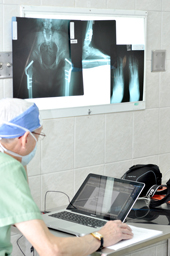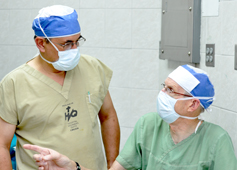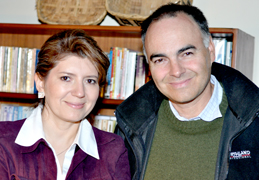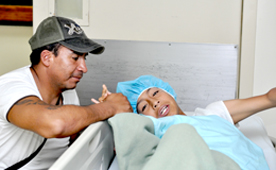MENU
(April 6, 2012 - by Harold Goerzen) More than 30 Ecuadorians have a chance to walk-some for the first time-after undergoing surgeries by an international team of orthopedic surgeons who recently donated their time and talents in Ecuador.
Led by Dr. Jim Gage, a retired Minnesota physician, a total of 20 surgeons from eight countries worked at HCJB Global Hands' hospital in Quito, Ecuador, Feb. 24-March 15. Except for one person, the 32 patients were children ranging in age from 3 months to 16 years, most deformed by cerebral palsy (CP).
"The surgeries we do are largely to correct skeletal deformities, lengthen muscles that are contracted, and balance muscle forces," Gage said. "This may significantly improve their gait, but it won't be normal. In addition, because of the knowledge that we've obtained over the years with gait analysis, we're comfortable in correcting all of these deformities simultaneously with two teams of surgeons-one team working on each side of the patient-which is one of the things that differentiates our approach from conventional CP surgery."
This was the case for a 16-year-old youth who was born paralyzed in his lower extremities due to spina bifida, causing a "lot of skeletal deformities as he has grown," Gage added. Such patients often need a series of surgeries to correct new problems that emerge as they develop and grow.
Surgeons at Hospital Vozandes-Quito (HVQ) had earlier rotated both the young man's femurs, giving him some mobility, but then his left foot began twisting away from his body at an awkward angle. This made walking nearly impossible.
"We did surgery to realign the foot so it was pointed in the right direction," Gage explained. The surgeons rotated his tibia (shinbone) and lengthened the talus bone in the foot using a bone graft which the doctors had brought from the St. Paul, Minn.-based Gillette Children's Specialty Healthcare. This is an independent, nonprofit hospital that focuses on pediatric medical treatment and research.
Other surgeons came from Colombia, Chile, Venezuela, Ecuador, Brazil, Germany and Sweden. "The treatment for CP is not good anywhere in the world-not even in the U.S.," said Gage, 73, who has been leading surgical teams to Ecuador since 1996.
"The gait analysis laboratory that we opened in Connecticut in 1981 has changed the way we treat CP enormously. But it's still not accepted by many of the orthopedic surgeons in the U.S.," Gage related. More recently such gait analysis labs have been established in Argentina, Chile, Colombia, Venezuela and Ecuador.
Dr. Eckehart Wolff, whose surgical work at the mission's jungle hospital in Shell brings him into contact with kids who walk with great difficulty or not at all, coordinates many of the details of the doctors' annual visit to Quito and does follow-up work with patients, including spiritual care. "There were lots of good spiritual conversations with the parents," he said.
Carlos was about 18 years old when he came to HVQ. "He couldn't walk, and we operated on him three times in three years," Wolff recounted. "Now he's walking with crutches. He also became a believer and began attending a seminary. He plans to be a pastor. It's good to see!"
Wolff recalls an abandoned 1-year-old child, Michelle, who was crippled when she was first brought to him. After two operations, however, she could walk. "I will never forget this. I saw her eyes beaming. It was a whole new world for her." The girl, now 12 years old, walks without crutches.
Several years ago surgeons operated on Narciso, 15, who has needed several surgeries throughout the years. "He was crawling … he couldn't do anything else … but now he can walk with a walker," Wolff recounted. "Since he doesn't have muscles in certain areas, he'll never [have full mobility], but yes, he can walk!"
A Chilean orthopedic surgeon, Dr. Alejandro de la Maza, said of the work, "to help the children is to learn how to do it. With this knowledge I can return to my country and do it correctly."
Dr. Camilo Turriago from Bogota, Colombia, has been making the annual trips to Quito for a decade. He said he's learned "a lot of new techniques and knowledge on how to treat children with gait disorders. It's also very nice to meet people from many countries so we learn from each other. We then take what we learn and apply it in our own countries."
It was the third Ecuador visit for Turriago's colleague, Dr. Astrid Medina, who was thrilled with the opportunity to learn more of the new technology. "I like to help people; and I like to learn from Dr. Gage and the other surgeons in South America," she said. She served as the principal surgeon on a 5-year-old-girl named Valentina who was born with CP.
"The patient had orthopedic surgery two or three years ago on her hip," Medina explained. "We removed the plates and the screws from her two femurs and fixed an ugly scar from the previous surgery. Today she can walk without any aids!"
For the first time an Ecuadorian surgeon, Dr. Geovanny Oleas, an orthopedist at the Baca Ortiz Pediatric Hospital in Quito, joined the surgical team. Wolff said he "really captured the vision" to operate on CP patients, some of whom had their costs covered by Ecuador's newly expanded social security system.
"Thank you for sharing your medical knowledge and surgical techniques," Oleas wrote to Gage afterwards. "And above all, thank you for giving us inspiration. It will force us to make changes in our situation."
"Don't forget us because we'll always remember you doing a good work-giving smiles to our children with CP! We will be waiting for you next year," concluded Oleas.
Source: HCJB Global
 |
| Dr. Jim Gage checks a patient's xrays and messages on his laptop. |
"The surgeries we do are largely to correct skeletal deformities, lengthen muscles that are contracted, and balance muscle forces," Gage said. "This may significantly improve their gait, but it won't be normal. In addition, because of the knowledge that we've obtained over the years with gait analysis, we're comfortable in correcting all of these deformities simultaneously with two teams of surgeons-one team working on each side of the patient-which is one of the things that differentiates our approach from conventional CP surgery."
This was the case for a 16-year-old youth who was born paralyzed in his lower extremities due to spina bifida, causing a "lot of skeletal deformities as he has grown," Gage added. Such patients often need a series of surgeries to correct new problems that emerge as they develop and grow.
 |
| Visiting surgeons operate on an Ecuadorian youth. |
"We did surgery to realign the foot so it was pointed in the right direction," Gage explained. The surgeons rotated his tibia (shinbone) and lengthened the talus bone in the foot using a bone graft which the doctors had brought from the St. Paul, Minn.-based Gillette Children's Specialty Healthcare. This is an independent, nonprofit hospital that focuses on pediatric medical treatment and research.
Other surgeons came from Colombia, Chile, Venezuela, Ecuador, Brazil, Germany and Sweden. "The treatment for CP is not good anywhere in the world-not even in the U.S.," said Gage, 73, who has been leading surgical teams to Ecuador since 1996.
"The gait analysis laboratory that we opened in Connecticut in 1981 has changed the way we treat CP enormously. But it's still not accepted by many of the orthopedic surgeons in the U.S.," Gage related. More recently such gait analysis labs have been established in Argentina, Chile, Colombia, Venezuela and Ecuador.
 |
| Dr. Eckehart Wolff (left) discusses a case with Dr. Gage. |
Carlos was about 18 years old when he came to HVQ. "He couldn't walk, and we operated on him three times in three years," Wolff recounted. "Now he's walking with crutches. He also became a believer and began attending a seminary. He plans to be a pastor. It's good to see!"
Wolff recalls an abandoned 1-year-old child, Michelle, who was crippled when she was first brought to him. After two operations, however, she could walk. "I will never forget this. I saw her eyes beaming. It was a whole new world for her." The girl, now 12 years old, walks without crutches.
Several years ago surgeons operated on Narciso, 15, who has needed several surgeries throughout the years. "He was crawling … he couldn't do anything else … but now he can walk with a walker," Wolff recounted. "Since he doesn't have muscles in certain areas, he'll never [have full mobility], but yes, he can walk!"
A Chilean orthopedic surgeon, Dr. Alejandro de la Maza, said of the work, "to help the children is to learn how to do it. With this knowledge I can return to my country and do it correctly."
 |
| Colombian surgeons Astrid Medina (left) and Camilo Turriago. |
It was the third Ecuador visit for Turriago's colleague, Dr. Astrid Medina, who was thrilled with the opportunity to learn more of the new technology. "I like to help people; and I like to learn from Dr. Gage and the other surgeons in South America," she said. She served as the principal surgeon on a 5-year-old-girl named Valentina who was born with CP.
"The patient had orthopedic surgery two or three years ago on her hip," Medina explained. "We removed the plates and the screws from her two femurs and fixed an ugly scar from the previous surgery. Today she can walk without any aids!"
 |
| A father consoles his son who has cerebral palsy before going into surgery. |
"Thank you for sharing your medical knowledge and surgical techniques," Oleas wrote to Gage afterwards. "And above all, thank you for giving us inspiration. It will force us to make changes in our situation."
"Don't forget us because we'll always remember you doing a good work-giving smiles to our children with CP! We will be waiting for you next year," concluded Oleas.
Source: HCJB Global
